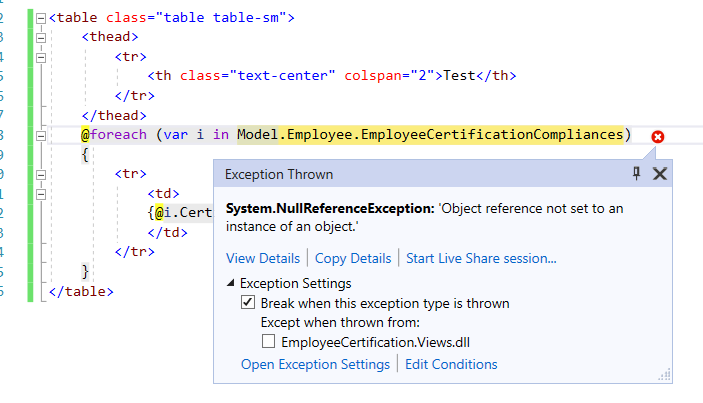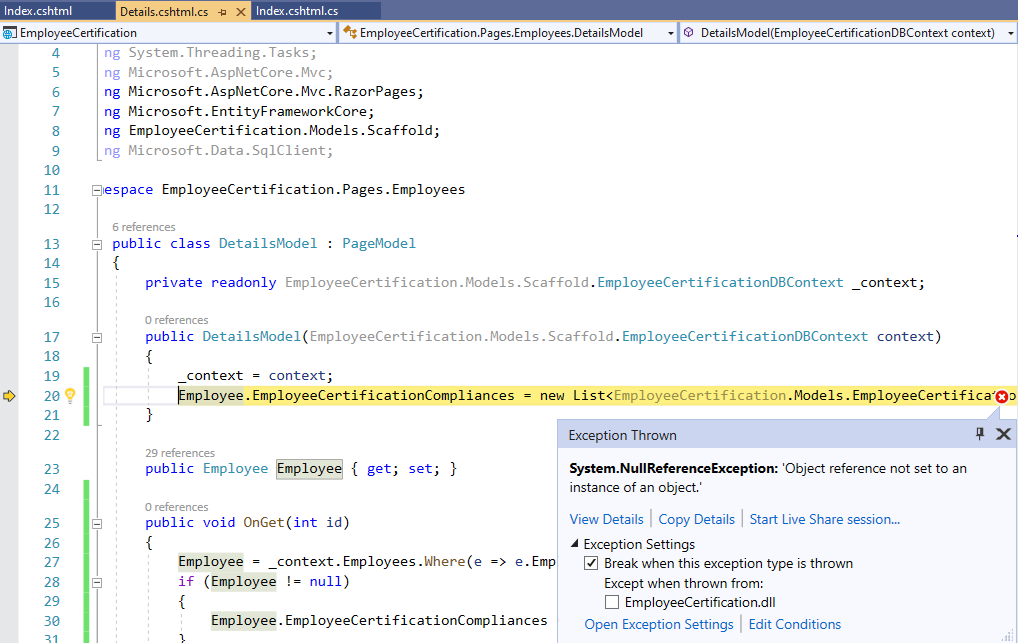How can I add a child entity that is derived from a table valued function to a parent model? I only need to read, no create, update or delete needed.
I've made two attemtps, v1 is to load the child into an IQuerayable and compose over it into the parent, v2 is listed below also.
Details.cshtml.cs v1
public class DetailsModel : PageModel
{
private readonly EmployeeCertification.Models.Scaffold.EmployeeCertificationDBContext _context;
public DetailsModel(EmployeeCertification.Models.Scaffold.EmployeeCertificationDBContext context)
{
_context = context;
}
public Employee Employee { get; set; }
public async Task<IActionResult> OnGetAsync(int? id)
{
if (id == null)
{
return NotFound();
}
IQueryable<Models.EmployeeCertificationCompliance> employeeCertificationCompliaceIQ
= _context.EmployeeCertificationCompliances
.FromSqlRaw("SELECT * FROM dbo.EmployeeCertificationCompliance(DEFAULT,DEFAULT)");
Employee = await (from a in employeeCertificationCompliaceIQ join x in _context.Employees on a.EmployeeId equals x.EmployeeId where a.EmployeeId == id select new Employee { Department = x.Department, EmployeeStatus = x.EmployeeStatus, JobTitle = x.JobTitle }).FirstOrDefaultAsync();
if (Employee == null)
{
return NotFound();
}
return Page();
}
}
Details.csthml.cs v2
public class DetailsModel : PageModel
{
private readonly EmployeeCertification.Models.Scaffold.EmployeeCertificationDBContext _context;
public DetailsModel(EmployeeCertification.Models.Scaffold.EmployeeCertificationDBContext context)
{
_context = context;
Employee.EmployeeCertificationCompliances = new List<EmployeeCertification.Models.EmployeeCertificationCompliance>();
}
public Employee Employee { get; set; }
public void OnGet(int id)
{
Employee = _context.Employees.Where(e => e.EmployeeId == id).FirstOrDefault();
if (Employee != null)
{
Employee.EmployeeCertificationCompliances = _context.EmployeeCertificationCompliances.FromSqlRaw("SELECT * FROM dbo.EmployeeCertificationCompliance(DEFAULT,DEFAULT)").ToList();
}
}
}
Details.csthml
@Anonymous
@默 EmployeeCertification.Pages.Employees.DetailsModel
@{
ViewData["Title"] = "Details";
}
<h1>Details</h1>
<div>
<h4>Employee</h4>
<hr />
<dl class="row">
<dt class="col-sm-2">
@Html.DisplayNameFor(model => model.Employee.EmployeeCode)
</dt>
<dd class="col-sm-10">
@Html.DisplayFor(model => model.Employee.EmployeeCode)
</dd>
<dt class="col-sm-2">
@Html.DisplayNameFor(model => model.Employee.First)
</dt>
<dd class="col-sm-10">
@Html.DisplayFor(model => model.Employee.First)
</dd>
<dt class="col-sm-2">
@Html.DisplayNameFor(model => model.Employee.Initial)
</dt>
<dd class="col-sm-10">
@Html.DisplayFor(model => model.Employee.Initial)
</dd>
<dt class="col-sm-2">
@Html.DisplayNameFor(model => model.Employee.Last)
</dt>
<dd class="col-sm-10">
@Html.DisplayFor(model => model.Employee.Last)
</dd>
<dt class="col-sm-2">
@Html.DisplayNameFor(model => model.Employee.Suffix)
</dt>
<dd class="col-sm-10">
@Html.DisplayFor(model => model.Employee.Suffix)
</dd>
<dt class="col-sm-2">
@Html.DisplayNameFor(model => model.Employee.PersonalEmailAddress)
</dt>
<dd class="col-sm-10">
@Html.DisplayFor(model => model.Employee.PersonalEmailAddress)
</dd>
<dt class="col-sm-2">
@Html.DisplayNameFor(model => model.Employee.CompanyEmailAddress)
</dt>
<dd class="col-sm-10">
@Html.DisplayFor(model => model.Employee.CompanyEmailAddress)
</dd>
<dt class="col-sm-2">
@Html.DisplayNameFor(model => model.Employee.HireRehireDate)
</dt>
<dd class="col-sm-10">
@Html.DisplayFor(model => model.Employee.HireRehireDate)
</dd>
<dt class="col-sm-2">
@Html.DisplayNameFor(model => model.Employee.SupervisorId)
</dt>
<dd class="col-sm-10">
@Html.DisplayFor(model => model.Employee.SupervisorId)
</dd>
<dt class="col-sm-2">
@Html.DisplayNameFor(model => model.Employee.Department)
</dt>
<dd class="col-sm-10">
@Html.DisplayFor(model => model.Employee.Department.DepartmentCode)
</dd>
<dt class="col-sm-2">
@Html.DisplayNameFor(model => model.Employee.EmployeeStatus)
</dt>
<dd class="col-sm-10">
@Html.DisplayFor(model => model.Employee.EmployeeStatus.EmployeeStatusCode)
</dd>
<dt class="col-sm-2">
@Html.DisplayNameFor(model => model.Employee.JobTitle)
</dt>
<dd class="col-sm-10">
@Html.DisplayFor(model => model.Employee.JobTitle.JobTitleCode)
</dd>
</dl>
</div>
<div>
<a asp-page="./Index">Back to List</a>
</div>
<table class="table table-sm">
<thead>
<tr>
<th class="text-center" colspan="2">Test</th>
</tr>
</thead>
@foreach (var i in Model.Employee.EmployeeCertificationCompliances)
{
<tr>
<td>
{@i.CertificationName}
</td>
</tr>
}
</table>
v1 Error Message

v2 Error Message

Parent Model
public partial class Employee
{
public Employee()
{
CertificationRuleEmployees = new HashSet<CertificationRuleEmployee>();
EmployeeCertifications = new HashSet<EmployeeCertification>();
EmployeeHistories = new HashSet<EmployeeHistory>();
}
public int EmployeeId { get; set; }
public string EmployeeCode { get; set; }
public string First { get; set; }
public string Initial { get; set; }
public string Last { get; set; }
public string Suffix { get; set; }
public byte? EmployeeStatusId { get; set; }
public int? JobTitleId { get; set; }
public string PersonalEmailAddress { get; set; }
public string CompanyEmailAddress { get; set; }
public int? DepartmentId { get; set; }
public DateTime? HireRehireDate { get; set; }
public int? SupervisorId { get; set; }
public virtual Department Department { get; set; }
public virtual EmployeeStatus EmployeeStatus { get; set; }
public virtual JobTitle JobTitle { get; set; }
public virtual ICollection<CertificationRuleEmployee> CertificationRuleEmployees { get; set; }
public virtual ICollection<EmployeeCertification> EmployeeCertifications { get; set; }
public virtual ICollection<EmployeeHistory> EmployeeHistories { get; set; }
/*manual*/
public virtual ICollection<Models.EmployeeCertificationCompliance> EmployeeCertificationCompliances { get; set; }
}
Child Model
public partial class EmployeeCertificationCompliance
{
public int EmployeeCertificationComplianceId { get; set; }
public string ComplianceStatusName { get; set; }
public int EmployeeId { get; set; }
public string EmployeeCode { get; set; }
public string First { get; set; }
public string Last { get; set; }
public string JobTitleName { get; set; }
public string DepartmentCode { get; set; }
public string DepartmentName { get; set; }
[DisplayFormat(DataFormatString = "{0:yyyy/MM/dd}", ApplyFormatInEditMode = true)]
public DateTime? HireRehireDate { get; set; }
public string CertificationName { get; set; }
public string RuleName { get; set; }
public bool AppliesToAllEmployees { get; set; }
public int? NumberOfYearsDue { get; set; }
[DisplayFormat(DataFormatString = "{0:yyyy/MM/dd}", ApplyFormatInEditMode = true)]
public int? CertificationDate { get; set; }
public virtual Scaffold.Employee Employee { get; set; }
}
EmployeeCertificationDBContext.cs (only relevant excerpts shown)
modelBuilder.Entity<EmployeeCertificationCompliance>(entity =>
{
entity.HasKey(c => new { c.EmployeeCertificationComplianceId });
entity.HasOne(d => d.Employee)
.WithMany(p => p.EmployeeCertificationCompliances)
.HasForeignKey(d => d.EmployeeId);
});
modelBuilder.Entity<Employee>(entity =>
{
entity.ToTable("Employee");
entity.HasIndex(e => e.EmployeeCode, "IX_Employee_Code")
.IsUnique();
entity.Property(e => e.CompanyEmailAddress).HasMaxLength(100);
entity.Property(e => e.EmployeeCode)
.HasMaxLength(4)
.IsFixedLength(true);
entity.Property(e => e.First).HasMaxLength(50);
entity.Property(e => e.HireRehireDate).HasColumnType("date");
entity.Property(e => e.Initial).HasMaxLength(10);
entity.Property(e => e.Last).HasMaxLength(50);
entity.Property(e => e.PersonalEmailAddress).HasMaxLength(100);
entity.Property(e => e.Suffix).HasMaxLength(5);
entity.HasOne(d => d.Department)
.WithMany(p => p.Employees)
.HasForeignKey(d => d.DepartmentId)
.HasConstraintName("FK_Employee_Department");
entity.HasOne(d => d.EmployeeStatus)
.WithMany(p => p.Employees)
.HasForeignKey(d => d.EmployeeStatusId)
.HasConstraintName("FK_Employee_Status");
entity.HasOne(d => d.JobTitle)
.WithMany(p => p.Employees)
.HasForeignKey(d => d.JobTitleId)
.HasConstraintName("FK_Employee_JobTitle");
});
dbo.EmployeeCertificationCompliance
CREATE FUNCTION [dbo].[EmployeeCertificationCompliance]
(
@CertificationRuleId INT = NULL,
@ComplianceStatus INT = NULL
)
RETURNS @returntable TABLE
(
EmployeeCertificationComplianceId INT IDENTITY PRIMARY KEY NOT NULL,
ComplianceStatusName NVARCHAR(50) NOT NULL,
EmployeeId INT NOT NULL,
EmployeeCode NVARCHAR(4) NULL,
[First] NVARCHAR(50) NULL,
[Last] NVARCHAR(50) NULL,
JobTitleName NVARCHAR(250) NULL,
DepartmentCode NVARCHAR(20) NULL,
DepartmentName NVARCHAR(250) NULL,
HireRehireDate DATE NULL,
CertificationName NVARCHAR(100) NOT NULL,
RuleName NVARCHAR(100) NOT NULL,
AppliesToAllEmployees BIT NOT NULL,
NumberOfYearsDue INT NULL,
CertificationDate DATETIME NULL
)
AS
BEGIN
IF ISNULL(@ComplianceStatus,1) = 1
BEGIN
--Compliant
INSERT INTO @returntable
(
ComplianceStatusName,
EmployeeId,
EmployeeCode,
First,
Last,
JobTitleName,
DepartmentCode,
DepartmentName,
HireRehireDate,
CertificationName,
RuleName,
AppliesToAllEmployees,
NumberOfYearsDue,
CertificationDate
)
SELECT
'Compliant',
ec.EmployeeId,
e.EmployeeCode,
e.[First],
e.[Last],
jt.JobTitleName,
d.DepartmentCode,
d.DepartmentName,
e.HireRehireDate,
c.CertificationName,
CASE
WHEN r2.RuleName = 'Due Every X Years' THEN REPLACE(r2.RuleName,'X', cr.NumberOfYearsDue)
ELSE r2.RuleName
END AS [RuleName],
cr.AppliesToAllEmployees,
cr.NumberOfYearsDue,
ec.CertificationDate
FROM dbo.CompliantEmployeeCertification(@CertificationRuleId) r
JOIN dbo.CertificationRule cr ON cr.CertificationRuleId = r.CertificationRuleId
JOIN dbo.EmployeeCertification ec ON r.EmployeeCertificationId = ec.EmployeeCertificationId
JOIN dbo.Employee e ON e.EmployeeId = ec.EmployeeId
JOIN dbo.Certification c ON c.CertificationId = cr.CertificationId
JOIN dbo.[Rule] r2 ON r2.RuleId = cr.RuleId
JOIN dbo.JobTitle jt ON jt.JobTitleId = e.JobTitleId
JOIN dbo.Department d ON d.DepartmentId = e.DepartmentId
END
IF ISNULL(@ComplianceStatus,0) = 0
BEGIN
--Non Compliant
INSERT INTO @returntable
(
ComplianceStatusName,
EmployeeId,
EmployeeCode,
First,
Last,
JobTitleName,
DepartmentCode,
DepartmentName,
HireRehireDate,
CertificationName,
RuleName,
AppliesToAllEmployees,
NumberOfYearsDue
)
SELECT
'Noncompliant',
r.EmployeeId,
e.EmployeeCode,
e.[First],
e.[Last],
jt.JobTitleName,
d.DepartmentCode,
d.DepartmentName,
e.HireRehireDate,
c.CertificationName,
CASE
WHEN r2.RuleName = 'Due Every X Years' THEN REPLACE(r2.RuleName,'X', cr.NumberOfYearsDue)
ELSE r2.RuleName
END AS [RuleName],
cr.AppliesToAllEmployees,
cr.NumberOfYearsDue
FROM dbo.NonCompliantEmployeeCertification(@CertificationRuleId) r
JOIN dbo.CertificationRule cr ON cr.CertificationRuleId = r.CertificationRuleId
LEFT JOIN dbo.Employee e ON e.EmployeeId = r.EmployeeId
LEFT JOIN dbo.Certification c ON c.CertificationId = cr.CertificationId
LEFT JOIN dbo.[Rule] r2 ON r2.RuleId = cr.RuleId
LEFT JOIN dbo.JobTitle jt ON jt.JobTitleId = e.JobTitleId
LEFT JOIN dbo.Department d ON d.DepartmentId = e.DepartmentId
END
RETURN
END


